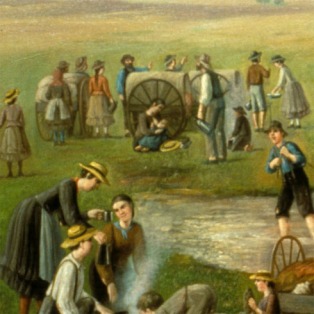For my Breastfeeding Educator Certification I had to write an article on a topic related to breastfeeding. I chose to write about breastfeeding in the NICU because of the pressure I felt as I was breastfeeding my oldest during his stay in a Level IV NICU.
Breastfeeding in a Neonatal Intensive Care Unit (NICU) can be extremely challenging. Not only does the baby have a serious condition that requires specialized medical care, but the practices of NICU’s may not be conducive to establishing breastfeeding. Strict schedules for feeding, medications for the baby and the baby being attached to several monitors can all make it difficult for the mother and baby to work out a breastfeeding relationship that can work effectively during hospitalization and after the baby is released.
Mothers are often under pressure to get breastfeeding perfect right away and that pressure often increases for the mother of a baby in the NICU since her baby must meet certain weight gain requirements before he can be released from the NICU. Doctors in NICU’s are often supportive of breastmilk as a medicine, but actual feeding from the breast are often not perceived as a high priority for the baby’s care, especially long term (Lieberman).
Because of the difficulties with breastfeeding, the rates of breastfeeding for NICU babies are often lower than the national average- which is far lower than ideal to begin with. The rates for infants receiving any breast milk at some point range from about 50% to 83%. However, those rates drop as the babies are released from the hospital. Studies have found that the rates of breast milk feeds at discharge are 64%, with the rate of breastfeeding being 38%. One study found that at 4 months of age, only 24% of infants born at less than 33 weeks gestation continue to receive some breast milk feedings. (Pineda, 8). Without a strategy to plan for long term breastfeeding, many mothers end up providing breastmilk through pumping during their baby’s hospital stay and struggling to breastfeed afterwards- if they breastfeed at all.
However, University of California San Diego Medical Center has instituted a Breastfeeding Pathway program to help mothers not only provide breastmilk in the NICU, but also establish long term breastfeeding for mothers and infants. The approach is somewhat novel. Instead of viewing breastfeeding as an event that may or may not happen, the Breastfeeding Pathway focuses on establishing breastfeeding in a step-by-step fashion while the mother is pumping.
The first step is to encourage skin-to-skin contact as much as possible as soon as the baby is stable. The next step is to establish non-nutritive sucking by getting the baby to suck as much as possible even if he is receiving little or no milk. Step three moves to nutritive breastfeeding where the baby starts taking feedings at the breast. Step four is bottle and breastfeeding where the mother provides feedings whenever she is at the baby’s bed side, and bottle feeding is utilized when she is not present.
Step five involves planning for breastfeeding after discharge. The mother is advised about ongoing pumping needs and how to transition towards breastfeeding as much as possible. The hospital also maintains a Premature Infant Nutrition Clinic to help mother continue the transition to breastfeeding.
The results for the Breastfeeding Pathway have been excellent. 82 percent of UCSD’s NICU babies are receiving breastmilk either at the breast or from a bottle at discharge. Of their infants under 1500 grams, 75 percent are receiving some amount of breastmilk at discharge. With the Breastfeeding Pathway program in place, the hospital has seen an increasing number of mothers getting their babies to the breast several times a day instead of several times a week (Stellwagen). Unfortunately, not every mother who has a baby in the NICU has so much support from the hospital.
Doulas and lactation consultants can utilize the principles of the Breastfeeding Pathway model with NICU mothers and babies to help. Most NICU’s permit or encourage Kangaroo Care to some degree and encouraging mothers to hold their babies skin-to-skin as much as possible under their particular circumstances is one of the best ways to start breastfeeding a baby in NICU. While the mother is pumping milk for her baby, she can still put him to the breast, first for non-nutritive sucking and then for nutritive sucking. As the mother and the baby fall into a pattern of successful breastfeeding, working with the mother and the hospital staff to encourage more feedings at the breast will help build both the mother and baby’s confidence and set the stage for breastfeeding after discharge.
Typically, the parents and baby are often under a great deal of stress making the move from NICU to home. The baby may require special care or may be on medications. Unfortunately, most hospitals do not have the kind of post-discharge support that UC San Diego provides for it’s NICU mothers and babies. Again, this is where doulas and other birth and breastfeeding helpers can step in with the Breastfeeding Pathways model. As discharge nears, the parents and their doula or lactation consultant can request to work out a plan for breastfeeding post discharge in consultation with the baby’s team of specialists and doctors.
The parents should receive contact information with local breastfeeding support services including WIC, the La Leche League, breastfeeding hotline numbers, lactation consultants, doulas who specialize in breastfeeding and any other resources available. Making sure that the parents don’t feel abandoned after discharge and know they have help available to them will go a long way towards helping ease the transition from the NICU into breastfeeding at home.
Works Cited
Liberman, Tanya. “Booby Traps Series: Booby Traps in the NICU.” Best For Babes. Retrieved from http://www.bestforbabes.org/booby-traps-series-booby-traps-in-the-nicu/Accessed 16 August 2016.
Pineda, Gittens Roberta. “Breastfeeding Practices In The Neonatal Intensive Care Unit Before And After An Intervention Plan.” University of Florida Department of Rehabilitation Science. August 2006, p. 8. Retrieved from ufdcimages.uflib.ufl.edu/UF/E0/01/56/59/00001/pineda_r.pdf. Accessed 15 August 2016.
University of California San Diego Medical Center. “Breastfeeding Pathway for All Mothers and Infants.” Accessed 17 August 2016 health.ucsd.edu/specialties/obgyn/maternity/newborn/nicu/spin/staff/Documents/Riley%2520BF%2520Pathway%2520NICU.docx+&cd=1&hl=en&ct=clnk&gl=us
Stellwagen, Lisa. “Re: Statistics on Breastfeeding Pathway?” Received by Nicholette Lambert, 18 August 2016.

